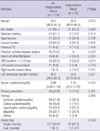1. Moss AJ, Hall WJ, Cannom DS, Daubert JP, Higgins SL, Klein H, Levine JH, Saksena S, Waldo AL, Wilber D, et al. Improved survival with an implanted defibrillator in patients with coronary disease at high risk for ventricular arrhythmia. N Engl J Med. 1996. 335:1933–1940.
2. Kadish A, Dyer A, Daubert JP, Quigg R, Estes NA, Anderson KP, Calkins H, Hoch D, Goldberger J, Shalaby A, et al. Prophylactic defibrillator implantation in patients with nonischemic dilated cardiomyopathy. N Engl J Med. 2004. 350:2151–2158.
3. Bardy GH, Lee KL, Mark DB, Poole JE, Packer DL, Boineau R, Domanski M, Troutman C, Anderson J, Johnson G, et al. Amiodarone or an implantable cardioverter-defibrillator for congestive heart failure. N Engl J Med. 2005. 352:225–237.
4. Kim YH, Kim JS. Clinical characteristics in patients with implantable cardioverter-defibrillator (ICD). Korean Circ J. 2004. 34:395–404.
5. Song PS, Kim JS, Shin DH, Park JW, Bae KI, Lee CH, Jung DC, Ryu DR, On YK. Electrical storms in patients with an implantable cardioverter defibrillator. Yonsei Med J. 2011. 52:26–32.
6. Schron EB, Exner DV, Yao Q, Jenkins LS, Steinberg JS, Cook JR, Kutalek SP, Friedman PL, Bubien RS, Page RL, et al. Quality of life in the antiarrhythmics versus implantable defibrillators trial: impact of therapy and influence of adverse symptoms and defibrillator shocks. Circulation. 2002. 105:589–594.
7. Lüderitz B, Jung W, Deister A, Marneros A, Manz M. Patient acceptance of the implantable cardioverter defibrillator in ventricular tachyarrhythmias. Pacing Clin Electrophysiol. 1993. 16:1815–1821.
8. Dichtl W, Wolber T, Paoli U, Brüllmann S, Stühlinger M, Berger T, Spuller K, Strasak A, Pachinger O, Haegeli LM, et al. Appropriate therapy but not inappropriate shocks predict survival in implantable cardioverter defibrillator patients. Clin Cardiol. 2011. 34:433–436.
9. Cevik C, Perez-Verdia A, Nugent K. Implantable cardioverter defibrillators and their role in heart failure progression. Europace. 2009. 11:710–715.
10. Higgins SL, Lee RS, Kramer RL. Stability: an ICD detection criterion for discriminating atrial fibrillation from ventricular tachycardia. J Cardiovasc Electrophysiol. 1995. 6:1081–1088.
11. Kühlkamp V, Dörnberger V, Mewis C, Suchalla R, Bosch RF, Seipel L. Clinical experience with the new detection algorithms for atrial fibrillation of a defibrillator with dual chamber sensing and pacing. J Cardiovasc Electrophysiol. 1999. 10:905–915.
12. van Rees JB, Borleffs CJ, de Bie MK, Stijnen T, van Erven L, Bax JJ, Schalij MJ. Inappropriate implantable cardioverter-defibrillator shocks: incidence, predictors, and impact on mortality. J Am Coll Cardiol. 2011. 57:556–562.
13. Daubert JP, Zareba W, Cannom DS, McNitt S, Rosero SZ, Wang P, Schuger C, Steinberg JS, Higgins SL, Wilber DJ, et al. Inappropriate implantable cardioverter-defibrillator shocks in MADIT II: frequency, mechanisms, predictors, and survival impact. J Am Coll Cardiol. 2008. 51:1357–1365.
14. Germano JJ, Reynolds M, Essebag V, Josephson ME. Frequency and causes of implantable cardioverter-defibrillator therapies: is device therapy proarrhythmic? Am J Cardiol. 2006. 97:1255–1261.
15. Bhavnani SP, Coleman CI, White CM, Clyne CA, Yarlagadda R, Guertin D, Kluger J. Association between statin therapy and reductions in atrial fibrillation or flutter and inappropriate shock therapy. Europace. 2008. 10:854–859.
16. Kleemann T, Becker T, Doenges K, Vater M, Senges J, Schneider S, Saggau W, Weisse U, Seidl K. Annual rate of transvenous defibrillation lead defects in implantable cardioverter-defibrillators over a period of >10 years. Circulation. 2007. 115:2474–2480.
17. Keren A, Sears SF, Nery P, Shaw J, Green MS, Lemery R, Gollob MH, Amyotte B, Birnie DH. Psychological adjustment in ICD patients living with advisory fidelis leads. J Cardiovasc Electrophysiol. 2011. 22:57–63.
18. Marcus GM, Chan DW, Redberg RF. Recollection of pain due to inappropriate versus appropriate implantable cardioverter-defibrillator shocks. Pacing Clin Electrophysiol. 2011. 34:348–353.
19. Lo R, Al-Ahmad A, Hsia H, Zei PC, Wang PJ. Optimal Programming of ICDs for Prevention of Appropriate and Inappropriate Shocks. Curr Treat Options Cardiovasc Med. 2008. 10:408–416.
20. Swerdlow CD, Gunderson BD, Ousdigian KT, Abeyratne A, Sachanandani H, Ellenbogen KA. Downloadable software algorithm reduces inappropriate shocks caused by implantable cardioverter-defibrillator lead fractures: a prospective study. Circulation. 2010. 122:1449–1455.
21. Auricchio A, Meijer A, Kurita T, Schloss E, Brinkman K, Claessens-van Ooijen M, Sterns L. Safety, efficacy, and performance of new discrimination algorithms to reduce inappropriate and unnecessary shocks: the PainFree SST clinical study design. Europace. 2011. 13:1484–1493.
22. Gold MR, Ahmad S, Browne K, Berg KC, Thackeray L, Berger RD. Prospective comparison of discrimination algorithms to prevent inappropriate ICD therapy: primary results of the Rhythm ID Going Head to Head Trial. Heart Rhythm. 2012. 9:370–377.
23. Moss AJ, Greenberg H, Case RB, Zareba W, Hall WJ, Brown MW, Daubert JP, McNitt S, Andrews ML, Elkin AD. Long-term clinical course of patients after termination of ventricular tachyarrhythmia by an implanted defibrillator. Circulation. 2004. 110:3760–3765.
24. Poole JE, Johnson GW, Hellkamp AS, Anderson J, Callans DJ, Raitt MH, Reddy RK, Marchlinski FE, Yee R, Guarnieri T, et al. Prognostic importance of defibrillator shocks in patients with heart failure. N Engl J Med. 2008. 359:1009–1017.








 PDF
PDF ePub
ePub Citation
Citation Print
Print



 XML Download
XML Download